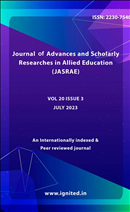Sustainable Cities and Urban Landscape – Need of the Hour
Keywords:
sustainable cities, urban landscape, landscape phenomena, natural forces, human activities, wise understanding, managing, separation, urban residents, local natural processes, expressions, immediate material resources, waste disposal services, unpleasant alien aesthetics, natural energy, society, new forms of energy, pretense of sustainability, urban settlements, progressive modification, sense of place, concrete significance, professional work, landscape knowledge, thought, contribution, sustainabilityAbstract
Landscape is more than a beautiful sight. Landscape is a term used frequently to describe theholistic view of the natural world, which is to say, the awareness of daily habitat or the outcome of theinteraction between natural forces and human activities. The purpose here is to point out how a wiseunderstanding and managing of the landscape phenomena largely contributes to a sustainable city. Aseparation between urban residents and local natural processes and expressions has resulted from aperspective on nature that reduces it to savor the goodness of immediate material resources and wastedisposal services, or to satisfy unpleasant alien aesthetics.In order to replace or make up for the lostnatural energy, society has been urged to develop new forms of energy under the pretense ofsustainability. Residents of urban settlements may perceive, experience, and breathe the progressivemodification of the landscape, and they may also value, control, and plan it, giving sustainability basedon a sense of place a concrete and practical significance. A sizable portion of professional work derivedfrom landscape knowledge and thought can make a substantial contribution to sustainability.References
Ryan, and C. Zumbrunnen. (2011) Integrating humans into ecology: opportunities and challenges for studying urban ecosystems. Bioscience 53:1169–1179.
Chiesura, A. (2015). The role of urban parks for the sustainable city. Landscape and Urban Planning 68:129–138.
Elmqvist, and C. Folke. (2015). History and local management of a biodiversity-rich, urban, cultural landscape. Ecology and Society 10(2):10.
Walker, B., and Salt, D. (2016). Resilience Thinking: Sustaining Ecosystems and People in a Changing World. 174p. Washington, D.C.: Island Press.
De Groot, R. (2012). Function analysis and valuation as a tool to assess land use conflicts in planning for sustainable multifunctional landscapes. Landscape Urban Plan, 75 (3–4), 175–186
Antrop, M. (2012). From holistic landscape synthesis to transdisciplinary landscape management. In: Tress, B., Fry, G., &Opdam, P., (eds), From Landscape Research to Landscape Planning: Aspects of integration, Education and Application. Netherland: Springer.
Berkes, F., and C. Folke. (2013). Back to the future: ecosystem dynamics and local knowledge. Pages 121–146 in L. Gunderson and C. S. Holling, editors. Panarchy. Understanding transformations in human and natural systems. Island Press, Washington D.C., USA
Pritchard, and C. T. Moore. (2013). Landscape change in the Southern Piedmont: challenges, solutions, and uncertainty across scales. Conservation Ecology 8(2):3
Musacchio, L. (2017).The scientific basis for the design of landscape sustainability: A conceptual framework for translational landscape research and practice of designed landscapes and the six Es of landscape sustainability. Landscape Ecol (2009) 24:993–1013
Drayton, B., and R. B. Primack. (2014). Plant species lost in an isolated conservation area in metropolitan Boston from 1894 to 1993. Conservation Biology 10:30–39.
Pouyat, and R. Pirani. (2015). Adopting a modern ecological view of the metropolitan landscape: the case of a greenspace system for the New York City region. Landscape and Urban Planning 39:295– 308.
Ahern, J. (2017). Green Infrastructure for Cities: The Spatial Dimension. In Novotny, V., & Brown, P., (Eds.). Cities of the Future: Towards Integrated Sustainable Water and Landscape Management, London: IWA Publishing, 267-283
Hellmund, P., & Smith, D. (2016). Designing Greenways: Sustainable Landscapes for Nature and People. London: Island Press
Knorr, L., (2011). The Birth of the Theory of Urban Green Systems in Britain and Hungary, Correspondence between Thomas H. Mawson and BélaRerrich concerning Urban Design Principles. First International Conference “Horticulture and Landscape Architecture in Transylvania”. Agriculture and Environment Supplement 41-53
Wu, J. (2012).A Landscape Approach for Sustainability Science Weinstein, M., & Turner, R., (eds.). Sustainability Science: The Emerging Paradigm and the Urban Environment, Media New York: Springer Science & Business.











